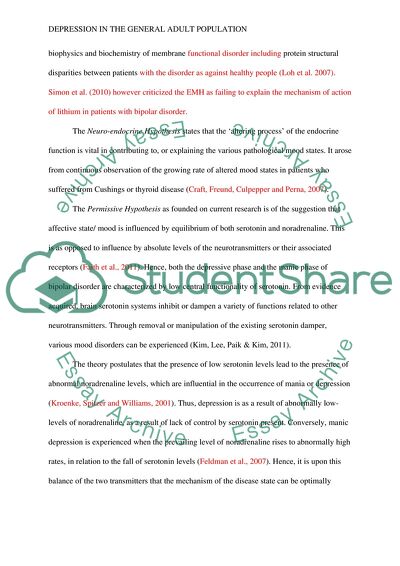
- Home
- Free Samples
- Premium Essays
- Editing Services
- Extra Tools
- Essay Writing Help
- About Us
- Studentshare
- Subjects
- Nursing
- Depression in the General Adult Population as a Disease Process
Depression in the General Adult Population as a Disease Process - Research Paper Example

- Subject: Nursing
- Type: Research Paper
- Level: Masters
- Pages: 23 (5750 words)
- Downloads: 0
- Author: nfritsch
Extract of sample "Depression in the General Adult Population as a Disease Process"
Because pathophysiology describes the functional changes seen in a person as a result of a disease (Faith et al., 2011), the pathophysiology of depression is best understood when depression is broken down into its different forms. This is because each form of depression is said to be linked with a different functional change when the condition of depression is observed in a patient (Li, Fitzgerald, and Rodin, 2012). Some major forms of depression and the different pathophysiology that may be associated with them are thus discussed from different theoretical perspectives.
Some of the major theories proposed with the aim of explaining the pathology of depressive disorder include the Biogenic Amine Hypothesis, the Permissive Hypothesis, the Neuro-endocrine Hypothesis, the Electrolyte Membrane Hypothesis, the Receptor Sensitivity Hypothesis, and the Serotonin-only Hypothesis (Halverson & David, 2014). The Electrolyte Membrane Hypothesis (EMH) explains the pathophysiology of bipolar disorder depression from the perspective of state-related fluctuations that take place in manic depressive illnesses such as body weight and urine volume (Saravane et al., 2009). The EMH explains that once a patient has bipolar disorder, there will be biophysics and biochemistry of membrane functional disorder including protein structural disparities between patients with the disorder and healthy people (Loh et al. 2007). Simon et al. (2010) however criticized the EMH as failing to explain the mechanism of action of lithium in patients with bipolar disorder.
The Neuro-endocrine Hypothesis states that the ‘altering process’ of the endocrine function is vital in contributing to or explaining the various pathological mood states. It arose from continuous observation of the growing rate of altered mood states in patients who suffered from Cushing's or thyroid disease (Craft, Freund, Culpepper, and Perna, 2007).
...Download file to see next pages Read MoreCHECK THESE SAMPLES OF Depression in the General Adult Population as a Disease Process
Major Depressive Disorder
Public Health Problem & Solution Paper
Effect Disorders Have on Adult Neurogenesis
How Exercise Can Help With the Healing of Depression
Adult Women and Depression
The Impact of Depression on an Elderly Persons Well-Being
Association Between Diabetes and Depression
Depression in Men among Black Minority Ethnic Groups

- TERMS & CONDITIONS
- PRIVACY POLICY
- COOKIES POLICY